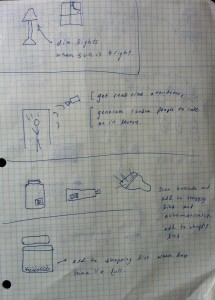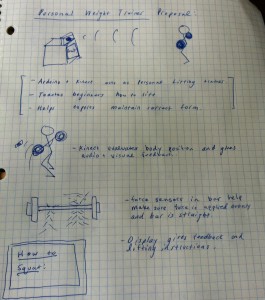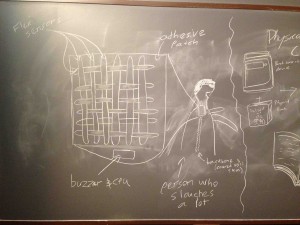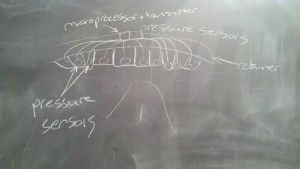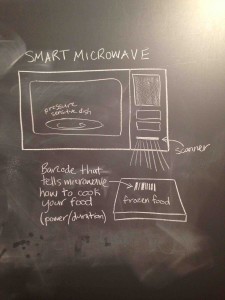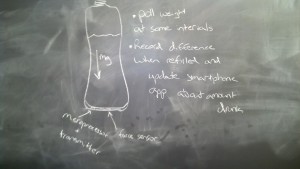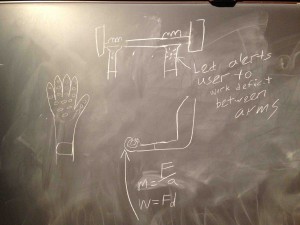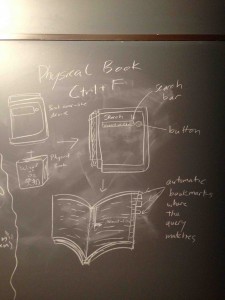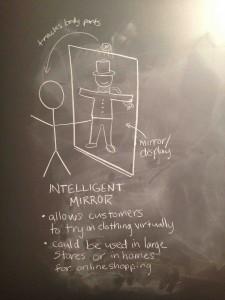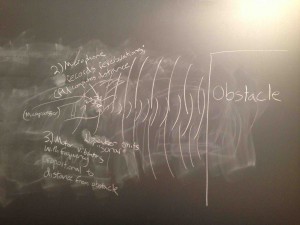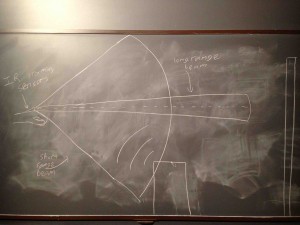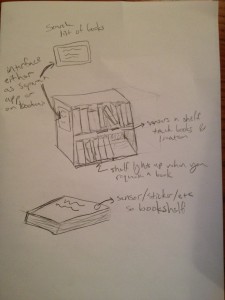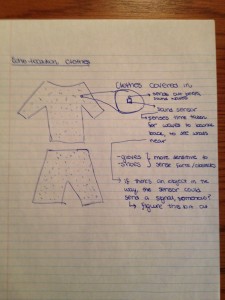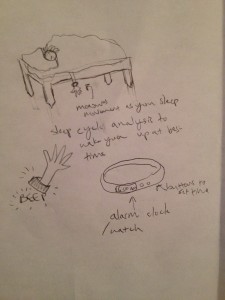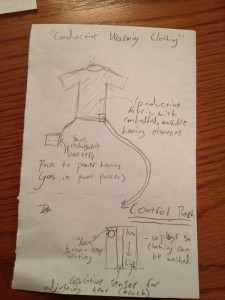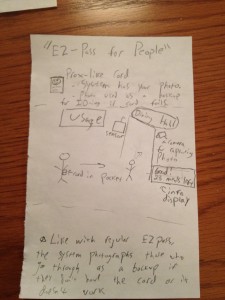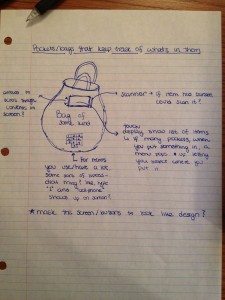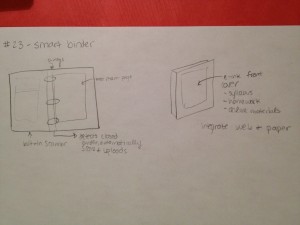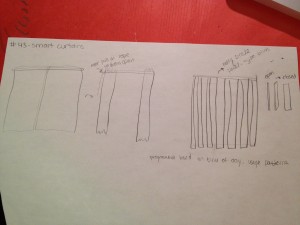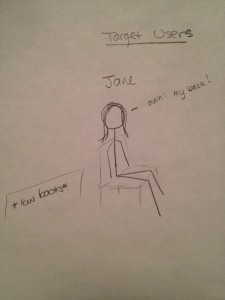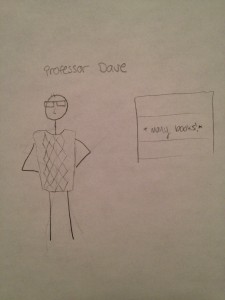Team Name:
Do You Even Lift?
Group Members:
Adam Suczewski, Andrew Callahan, Matt Drabick, Peter Grabowski
Brainstorming:
- Live music aid — Music device that changes based on movement/attitude of the crowd. Uses Kinect to sense motion, adjusts lights/sound/fog accordingly.
- Skateboard odometer/speeder to monitor travel data for the curious skateboarder. Communicates to watch display, or alternatively to LCD display on board.
- Device to display airplane information (flight number, etc) by pointing to an airplane.
- Gesture based interface for surgeons in OR — they can’t touch anything during the operation for risk of becoming not sterile, so a hands free interface for browsing patient records would be useful — also useful for other professions like butchers, potters
- Emergency condom delivery system — when you’re in an intimate situation where it may be inappropriate to get up and leave, send out a (private message) to a trusted contact that you need a special delivery.
- Display/Orb that indicates what club to go to based on where your friends are going to. One dial (with marks for each of the clubs) that integrates GPS data from friends and points to the club with the most friends
- There are frequently used commands in photoshop (any program, really). Create a pedal based interface to map to these frequently used commands, to allow users to enter input with their feet as well and increase throughput
- Secret knock or password to open door without key or prox. – motor to pull down on down handle
- Arduino in a house hears fire alarm and shuts off the gas line
- Full, new and improved smoke detector. Chemical sensor/light trap detects smoke. Alerts security company, calls your phone, takes pictures inside for insurance company
- Kinect interface that allows you to make gestures to change the channel, up the volume, turn it on/off. Voice recognition for Netflix commands, etc.
- Hardware interface for convenient ordering from seamless – does online ordering for a particular. One button for your favorite chicken parm, one button for sushi, etc.
- We could use mechanical turk to map orders to buttons so that the user doesn’t have to dig through the API – he can just say “2 slices pepperoni pizza from Dominos” and an anon does the hard work for 10 cents
- Automated shocking when user bites nails to help break bad habit. Could be kinect based, although that might be overkill. May be too hard to differentiate between “hand near face” and “biting nails”
- Device to wear while running that vibrates on your left or right side to indicate a turn coming up. Useful for novel routes — think about downloading other’s routes from a site like runkeeper and following them for the first time.
- Kinect/webcam at the gym watches you lift and identifies problems in your form
- Monitor lifting technique using force sensors in hands and feet to check if force is equal. Also use wrist watch with sensors on each leg/arm. Choose which exercise you are about to perform and get feedback
- Could integrate with Fitocracy or other account. Keep track of your progress
- Weight lifting equipment with sensors built in to check the balance of the bar. Sensors detect balance and movement of the bar itself to give feedback.
- Previous points assume you already know proper form and are looking to improve it. Kinect based system could teach you step by step, overlaying a video of your exercise with what a correct exercise would look like. Also uses voice cues.
- Help runners with running form using a treadmilll with force sensors to detect foot striking. Display foot strike data on a monitor to help runner’s technique.
- Detect when runners have bad form when tired and using sensors on legs and arms that can detect when they pass each other.
- Arduino detects when it’s too bright/dark in room and adjusts shades on windows. Useful for classrooms
- Arduino raises/lowers blinds to act as an alarm clock
- Arduino works as a physical thermostat by opening windows when the room is too hot and closing them when too cold. Could also turn fan on and off.
- Combine above three ideas for room maintenance system. Potential for cross communication — for example, it might be ok for the room to be dark and cold if you’re sleeping, but not during the day.
- System that photographs people entering lecture, builds real-time attendance list, and can select a random attendee to answer a question. Solves problem of tracking attendance (students can sign in other students on sign in sheet), as well as wanting to pick a random student to answer a question
- When you’re low on some household supply, scan your barcode on device, and it gets added to an online shopping list/shopping cart, such as fresh direct or amazon.
- “Smart Container.” Have plastic containers that can be filled with water, flour, etc. that automatically adds that ingredient to your shopping list when the container is less than a quarter full.
- Integrate the above two into automated kitchen. Containers and to-do list converse, to answer more complicated questions like “Do I have what I need to make cookies tonight?” or “What do I need to pick up at the store if I want to make chicken parm tonight?”
- Arduino locks your door while you’re busy programming (while you have an IDE open or while you’re typing code etc). Or more realistically, illuminates a “Do no disturb” light
- Single button to open IDE, enable warning light, and initialize brew of favorite coffee. Enter “programming mode”
- Arduino turns off toaster when toast is done. Can be done with a light sensor that can detect the change in color as it browns, or a light trap/smoke sensor (depending on how dark you like your toast.
- Arduino listens while you make popcorn and turns off microwave when popcorn is done
- One better – Arduino uses netflix API to detect that you’re starting a movie, and makes popcorn for you.
- Automated smoothie making with arduino. Preset options to streamline process.
- Light controls for cyclists — button to signal for left right turns, as well as breaking lights
- Arduino measures out ingredients for you in the kitchen — you enter in a recipe, and it dispenses the correct amount of flour, sugar, etc for you.
- “Weasley clock” — location of various family members on dial, if they’re in predefined locations
- Location sensors on valuable items, with dial indicator of where they are in the house
- Device analyzes tempo of sex and plays appropriate music
- Arduino resets your WRT-54G (router). Have an infrared or radio remote so you can do it from the comfort of your couch upstairs
a. Also keeps from you from having to go under the desk or somewhere inconvenient.
- Device adjusts oven temperature based on meat thermometer and maybe color of steak
- Arduino power control for dishwasher. Monitors power grid data, and turns on dishwasher when power cost is lowest (i.e., middle of the night). Reduces peak (max) power usage, and more evenly distributes power usage over the course of the day.
- An Arduino based system that works as an air freshener that detects bad smells and activates a burst of delicious smell. Could be useful for public restrooms, and potentially more efficient than timer based systems.
- In a car, Arduino continually monitors the air coming through vents. If it detects bad air quality it rapidly shuts the vents. It could check for skunk or nasty north Jersey refineries or smelly truck brakes.
- Arduino brews tea for you by removing the teabag at the appropriate time. Useful if you need to brew many bags of tea at once, with specific brew times (consider Teavana or Infini-tea)
- Bartenders place bottles on LED stand. When they go to make a drink, the appropriate bottles light up. Decreases time required to find the bottles, increasing bar’s throughput. Especially good for new bartenders. Also looks pretty cool.
- Above could hook-in with DJ system, for song-themed drinks. For example, when Margaritaville comes on, you could offer a half price special on margaritas for the duration of the song. “Flash sale” mentality would potentially increase drink sales. Bartending system could flash or otherwise indicate ahead of time, so the bartender could prepare for the imminent rush.
- Place microphones around room or other venue to sense volume. If speaker is too loud, lower volume levels. If speaker is too soft, arduino aims microphone to maximize sound captured (or raises volume levels). Could use tracking system to make sure microphone is pointed optimally at face
- Glove for conductor of an orchestra. They can’t move or gesture while conducting, but may need to communicate during the performance with audio/house staff or parts of the orchestra. Glove has buttons to send predefined messages, or alternatively has a one handed keyboard system
- Washing machine status light (for the living room, kitchen, etc.). Make it easy to see if your permanent press load is finished, so it doesn’t wrinkle while sitting in the drier.
Sketches:
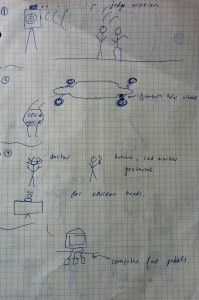
1) Live music aid
2) Skateboard odometer/speedometer watch
4) Gesture interface for messy hands
7) Computer foot pedals for commonly used commands.
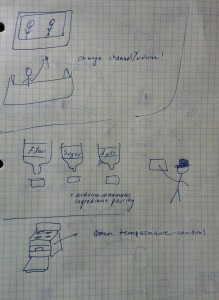
11) Gestures to change tv settings
36) Auto measuring of kitchen indredients
41) Oven meat temperature adjuster
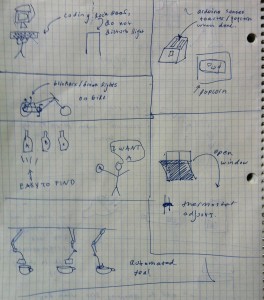
Clockwise from top left:
29) Door lock when busy
32) Popcorn / Toast monitor
41) Auto adjust thermostat
45) Auto tea-brewing
46) LED bartender helper
Bike brake lights/ turn signals
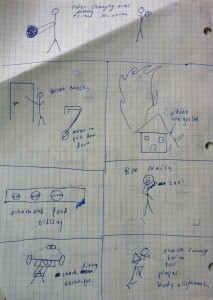
Clockwise from top left:
6) Friend finding orb
9) Gas line cutoff in fire
13) Bad habit/nail biting breaker
20) Running form detector
15) Lifting technique montior
12) Convienient food ordering
8) Secret knock to get in room
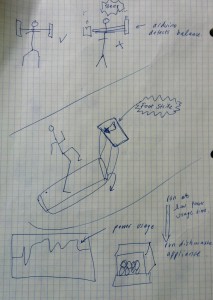
17) weight sensors in lifting equipment to check technique
19) Treadmill foot strike detector
42) Run appliances (dish washer) at low times on power grid.
Short description:
Our first choice is a kinect-based trainer for the weight room. This device would use a camera and body-tracking APIs to identify problems in form and point out fixes. It could also provide a full tutorial on how to do the lift, useful for a complete novice. We like the idea because:
- We can approach the problem from a few different areas
- Kinect APIs should make it easy to watch the lifter and identify problems
- The advice would be very useful to the end-user, as it would be a very inexpensive (free, probably) way to check your form and avoid mistakes that could cause injury
- Commercial gyms are always looking to buy the latest gimmicky things
If we can’t have a kinect, our second choice is to try using a standard webcam-based system to the same effect, or to just go and spend all of our budget on another kinect.
If none of the above pans out, another project we are interested in is an Arduino-based window thermostat, ideal for dorm rooms. The device could open and shut the windows when the room is too hot or cold, and could roll up the shades in the morning when it’s time to wake up. We think this could accomplished pretty efficiently and would be useful for your typical lazy college student. It has room for extra goals in the form of learning and adapting to the user’s patterns.
Full Description:
Target User Group – The system would aimed primarily at novice weightlifters. The system could start from scratch, assuming no user knowledge of the lift, and teach it in stages. The system’s ability to identify subtle problems in form could be useful for trainees of all skill levels, though, as some common problems in form are very tricky to notice on your own (e.g. not having the back in the right spot on the back in a squat, or allowing the lumbar to round in a deadlift).
Problem Description & Context – We are looking to solve the problem of inexperienced weightlifters doing lifts inefficiently or dangerously by compromising their form. This solution could offer guidance on how to correct these problems, as well as more general advice on routines and workout programming. We envision addressing this in the weightroom, right where the user does his/her lifts. Users will have varying experience levels, and we don’t want to interrupt experienced lifters who would rather not be annoyed. Some users might have different or mis-concieved opinions on how a lift should be done, and might choose to ignore some or all of the advice given. Some users might have friends or (human) trainers with them to help out.
Technology Platform – We imagine this working with a Windows PC (probably one of our laptops initially) hooked up to a Kinect. This gives us body-tracking APIs that will make it much easier to identify what the user is doing. Unless these saturate the gym, they could be placed on something like a cart with wheels, so that it can monitor different exercises or from different angles. If the idea takes off, the technology could be incorporated directly into exercise equipment like squat racks.
More Detailed Design Sketches:
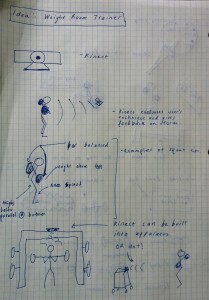
-Using a kinect, monitor lifting technique and give the user feedback
-System can evaluate technique and also give instructions to user
-Can be built in to lifting equipment or implemented separtately
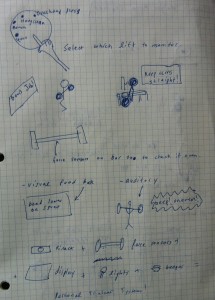
-User will be able to select from different lifts they want to perform.
-Visual and auditory display will give feedback (“Good Job!”, “Keep Arms Even”…) as well as act as the interface for selecting lifts or receiving instruction.
-Monitor/Audio can show “ideal” lifts teach user.

